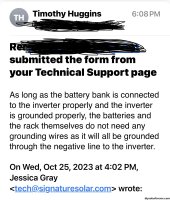MySolarAddiction
Energy Farming Is Habit Forming
I'm about to have all of my equipment finally delivered to do my install and was wondering what current users are running grounds for 6 EG4 LL V2 batteries in a rack. In the videos I've seen so far I don't see ground wires connected to the grounding lug on each battery so I'm thinking they are grounding the cabinet? They come in a metal box and you would be installing them in another metal box that could be grounded. Will be doing this soon my rack will finally show up tomorrow according my last phone call with the freight company. Thanks for any advice in advance.









